
“Either figure out how to keep elevators operational or figure out an alternative to them and stop installing them.”
– Betsy Reese, in an email to PBOT
The elevators that take bicycle riders up and down the Bob Stacey Overcrossing (originally called the Gideon Street Overcrossing) in southeast Portland are proving to be quite a problem for the Portland Bureau of Transportation.
As we reported in February 2022, during the bridge’s first 15 months of operation, the elevators were closed and out-of-order at least one-third of the time. It’s a big deal because this is an important connection across several rail tracks. And without the elevators, the only other viable option is several steep flights of stairs that are extremely challenging and often impossible for most people to navigate with a bike (or a stroller, a wheelchair, and so on…).
In May 2022, the City finally got the elevators working again and promised they’d be more reliable in the future. Unfortunately that has not been the case. They were first reported down on May 11th of this year. More than a month later, the elevators are still closed and PBOT doesn’t have a timeframe for when they’ll work again.
The City first blamed the problem on “unexpected motor failures” and parts that didn’t arrive fast enough due to “pandemic related delays” in the supply chain. When we last reported on this issue, PBOT seemed confident that the problem was fixed and they even installed a monitoring system (in partnership with Portland General Electric) that was supposed to sense motor issues and trigger a warning before they failed.
Whatever is going on, we’ve heard from a source, that it could take a long time to fix.
On June 5th, an unnamed source who has knowledge of the issue shared this:
“Those elevators have blown multiple lift motors since its opening, and they haven’t been able to figure out why yet. It seems to be an engineering design flaw. At first they thought it was power surges causing the issue, but PGE put up monitors in the area. Plus they installed a motor from a different manufacturer. But the motors still broke.
So now they are going to do an engineering forensics investigation. They have to contract it out and don’t have a timeline yet. They can’t replace the motors until they know what broke them in the first place. As you can imagine, these motors are very expensive.
There is no evidence human activity caused the motors to break.”
Adding to the problem is a jurisdictional issue: TriMet paid for the bridge and the installation of the elevators (it goes over a light rail line), but PBOT manages the facility and is responsible for ongoing maintenance. Given their budget situation these days, PBOT probably isn’t very excited about this unexpected bill and there might be some wrangling over who picks up the tab.
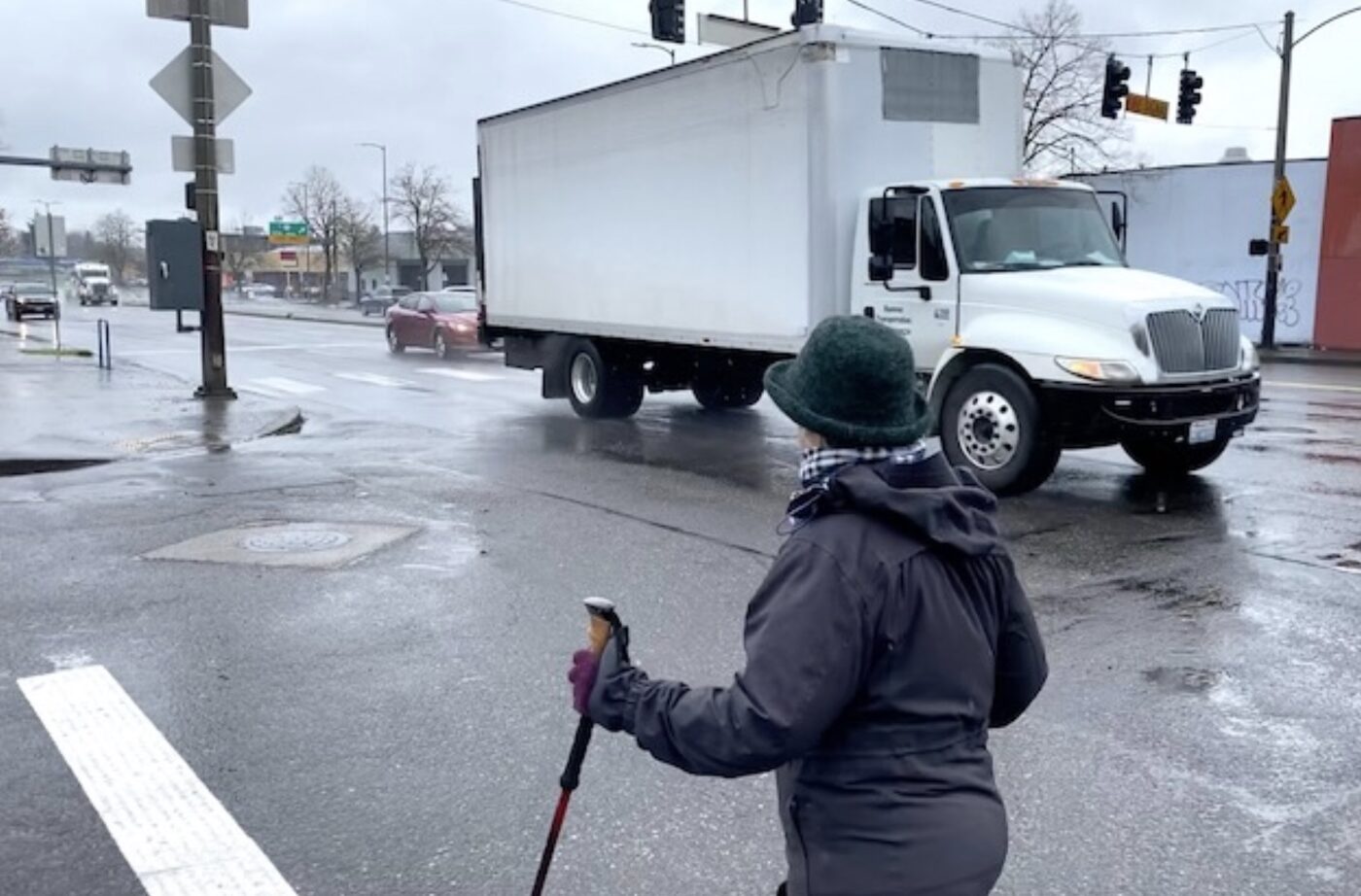
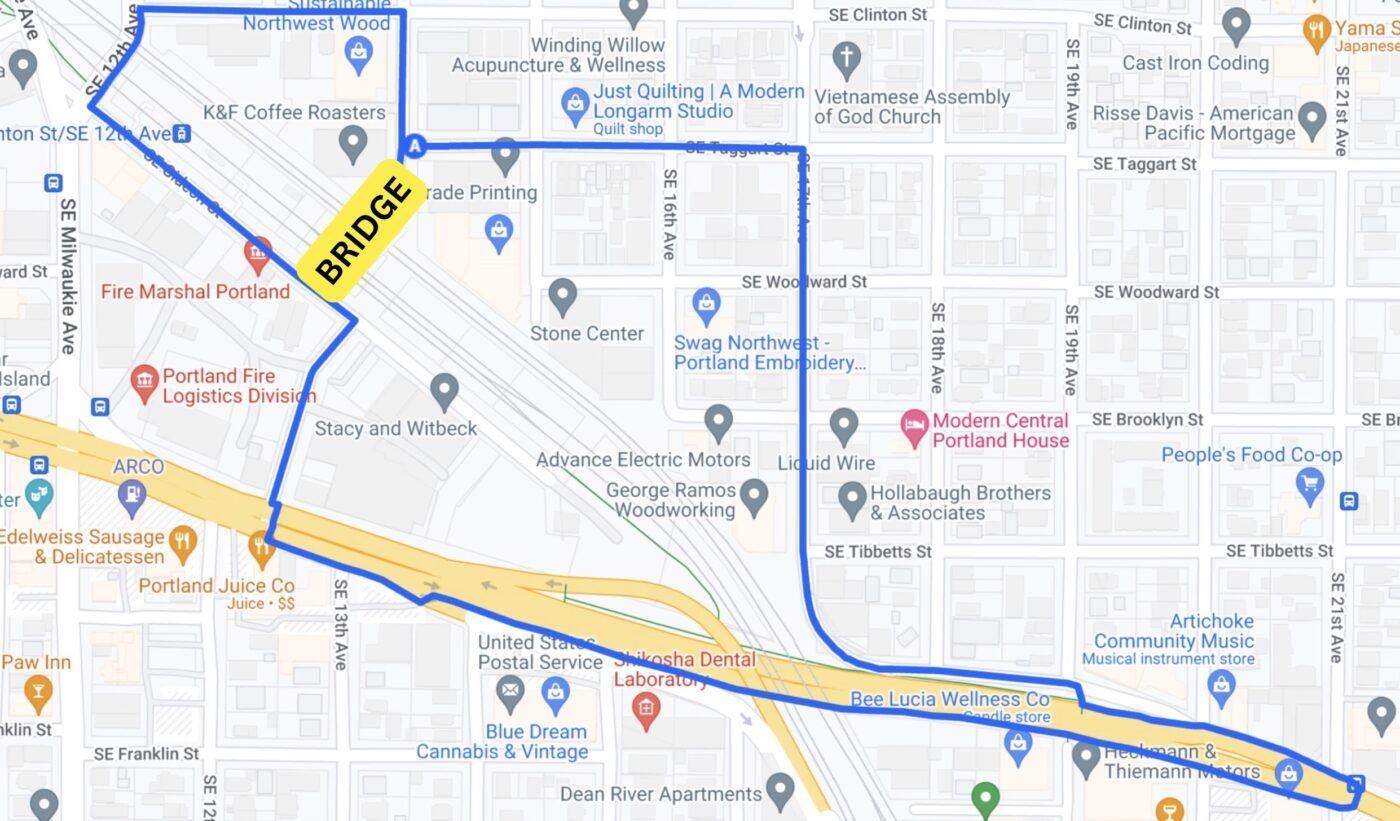
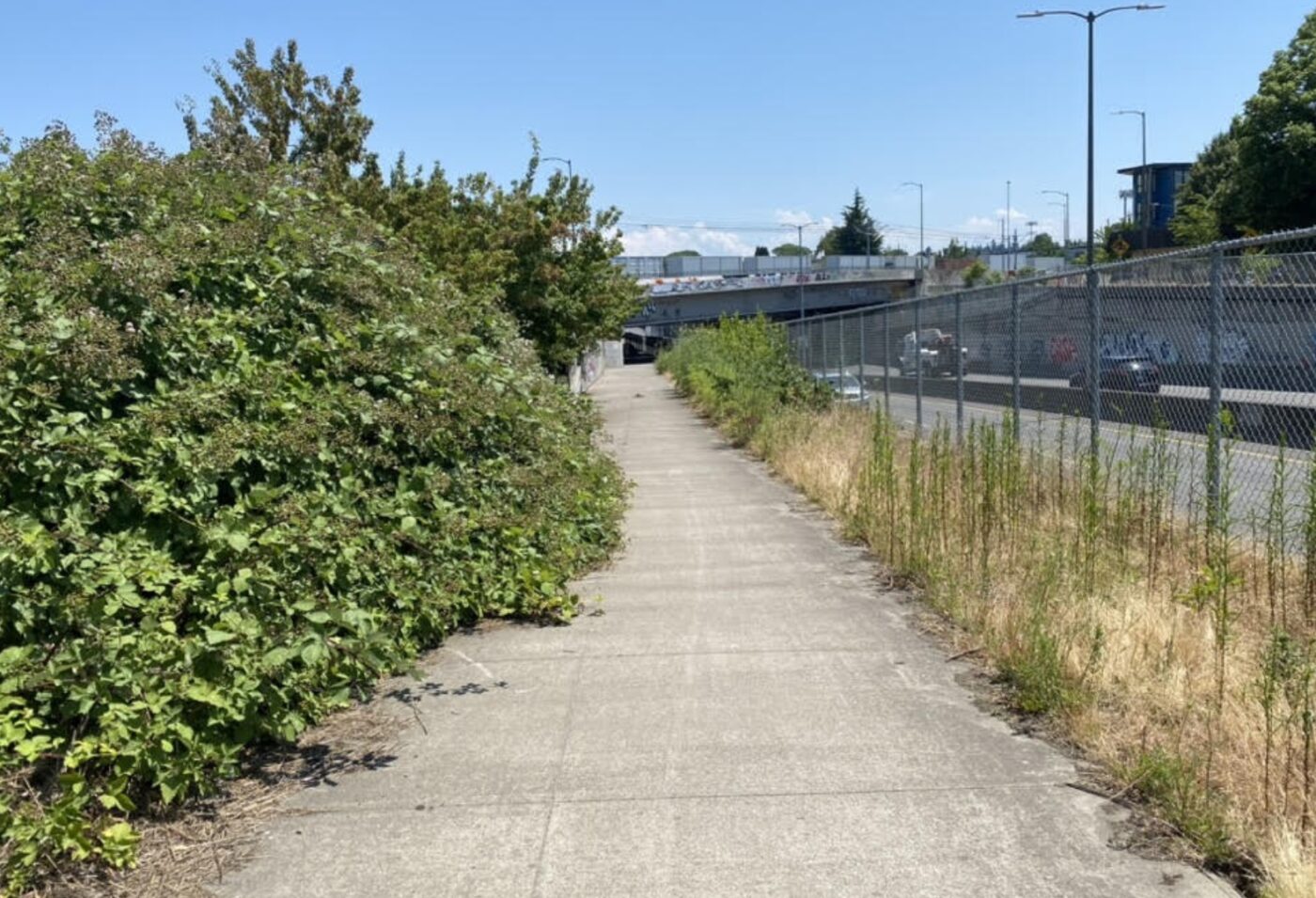
Adding even more grey hairs for PBOT is a push from a local activist who is not only concerned about the elevator, but who thinks the detour instructions and mitigation plan for the closure aren’t good enough. Betsy Reese is a veteran local transportation advocate who has worked with PBOT and other agencies for years on a variety of issues. She started an email chain this week that includes many top PBOT officials, other advocates, and members of the media.
Reese thinks the detour route recommended by PBOT is “dangerously impossible” because it has people crossing over SE Powell Blvd several times. A better detour, Reese says, is to stay on the north side of Powell and use the path underpass — a route that is easier and shorter; but is also prone to overgrown vegetation, lighting outages, and has often been the home of street campers. Reese adds that the situation will likely get worse as more people try to access the elevator when the forthcoming Gideon Street Temporary Alternative Shelter opens nearby later this summer. That site will be Portland’s largest homeless shelter with 140 living pods.
A resident of the nearby Brooklyn neighborhood on Reese’s email chain said he expects these issues to be addressed by the City as part of a good neighbor agreement related to the new shelter that is currently in the works .
Yesterday, PBOT Communications Director Hannah Schafer responded to Reese. “It is important for us to emphasize that these elevators are very complicated machines and are not breaking down due to neglect,” Schafer explained in an email. “We’re doing some additional investigations around the continued motor failure issues and recognize this is a frustrating situation for all!” Schafer said PBOT offers free rides, 24/7, for anyone who needs ADA accommodation when the elevators are out of service.
So far, Reese isn’t satisfied with that response.
“Either figure out how to keep elevators operational or figure out an alternative to them and stop installing them,” she wrote back to Schafer. “Clean up and maintain the vegetation on the underpass, and give correct detour instructions to use it.”
Stay tuned. We hope to share a remedy to the elevators and associated problems soon.



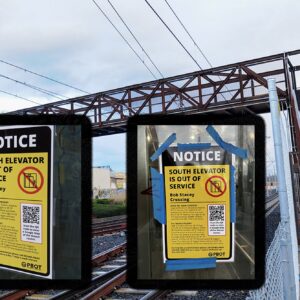
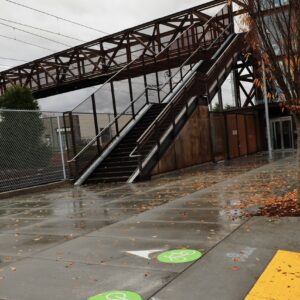
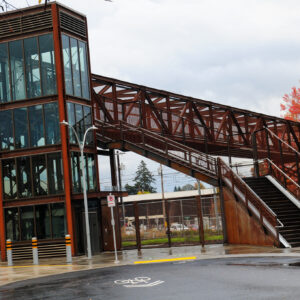
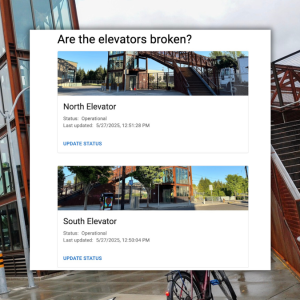
Thanks for reading.
BikePortland has served this community with independent community journalism since 2005. We rely on subscriptions from readers like you to survive. Your financial support is vital in keeping this valuable resource alive and well.
Please subscribe today to strengthen and expand our work.
Nice article, Jonathan. Thank you for shining a public light on this issue.
Here is a legible photo of that sign where people can read the verbal instructions to the PBOT detour and/or scan the QR code. I could not get the QR code to work for me, but here is the PBOT weblink to the detour instructions and map, https://www.portland.gov/transportation/pbot-elevators#toc-bob-stacey-overcrossing-at-gideon-street-in-southeast-portland.
Clearly, whoever put together these detour instructions has never been physically on the ground here, or apparently, even knows how to read a map, or access satellite photos or Google Street View. Those who are familiar with this area know it is literally impossible for anyone of any ability or on any conveyance to walk/roll this indicated route. Anyone not familiar who tries to follow the instructions is going to find themselves in multiple uncomfortable, confusing, and dangerous situations. Continuing to knowingly indicate this detour route is not only an embarrassment to PBOT, but a liability for taxpayers, and unconscionable for any caring human.
Lucky for PBOT, we’re not asking for a new expensive ADA MUP railroad underpass to avoid having to direct people on cargo bikes, using wheelchairs, on adaptive cycles, pushing baby strollers, or bicycling with young children to cross back and forth over deadly Powell Blvd., add over a mile to their detour, and use a steep non-ADA ramp. That remodeled north side MUP underpass was all done by 2015. We are just asking them to maintain it usable, and properly direct people to it.
I can’t help but to point out the utter absurdity of the conversation we’re having on this subject. The overcrossing bridge here is essentially a bandaid solution to our absolutely insane federal policy on freight trains. We criticize the fact that the FX2 line passes through a rail crossing and the fact that the elevators are in poor repair on this bridge, which I don’t mean to say aren’t legitimate criticisms or problems that need to be dealt with in the meantime, but we aren’t dedicating the same energy towards the fact that a rail crossing where you could be stopped for 20 or more minutes IF the train is moving and possibly for several hours if the train is stopped at the crossing is just untenable and not at all normal from a global perspective (see this video of what is said to be the longest freight train in Japan at 27 cars). We’re so focused on the symptoms that we don’t pay enough attention to the disease. The fact that we even need the Stacey Overcrossing at all is a symptom.
The freight rail transportation situation in Japan is so categorically different than it is here it’s not worth floating something like a 27 car train as being a reasonable limit.
A real solution – like nationalization of the rail network – is worth talking about. Reasonable length trains are also worth considering – but Brooklyn Yard is pretty undersized as intermodal yards go so I would expect “reasonable” to still mean that trains being assembled and blocking the crossing for 20+ minutes might still happen.
But the fact of the matter is that no one other than our Rep and Senators can realistically even start to push for anything on that front. And it doesn’t seem to be a focus – even if it really should be. In this reality, something like the Bob Stacey is a critical piece of infrastructure.
Don’t let me give you the impression that I’m saying otherwise. I understand the political reality of what I’m suggesting. I know that the Bob Stacey Overcrossing was important to construct while that bigger issue wasn’t getting solved. When I said “the fact that we even need the Stacey Overcrossing at all is a symptom,” that’s in part an acknowledgement of that need existing.
It just seems though that a world in which people die in ambulances because they get stuck at freight train crossings is a bad enough situation that a major change is warranted.
I’m not an expert on freight rail in the US or Japan, but your argument that the situations are different enough that it’s not worth mentioning Japan’s example for the US does closely resemble the argument that the Netherlands is so different from the US that we can’t reasonably implement their bike infrastructure here. It’s essentially using the status quo as an argument as to why we can’t change the status quo, which is circular. If on the other hand you have a specific reason why it can’t be implemented in the US, I’d be interested to hear it.
While we’re making incremental changes and alleviating symptoms, it’s worth looking at the bigger picture.
In this brutal Darwinian society, this is about as likely as nationalization as healthcare
PS: Medicare for all is not nationalization.
why do you hate aMeRiCa?
We focus on symptom relief here because there is no realistic prospect for cure. Perhaps it is absurd, but sometimes to make any progress at all, you have to deal with reality.
Unfortunately it’s been nothing but trouble for this poor crossing since it was built. This post is from 2021. As many say “you can’t have anything nice in the new Portland”. :(. Very frustrating this is what happens to bike and pedestrian infrastructure.
https://forums.bikeportland.org/t/gideon-ped-bike-overcrossing/981
Yeah, I steer clear of most elevators at MAX stops for this reason. I really feel for people who are less able-bodied and rely on these elevators. I wish we held people accountable for trashing public space.
Unfortunately “accountability”
is not in fashion in Portland (at least for the last 5 years or so. ).
Why does my toilet keep going up and down?!?!??
If we can’t keep elevators working then the prospects in the aftermath of The Big One, never mind the fallout from Runaway Climate Change, are grim indeed.
Why design systems with such tightly coupled systems? How do other countries solve these problems? Must we always screw up?
Aren’t elevators a solved problem/a mature technology? There must be about a million of them worldwide and most of them don’t go through motors like chewing gum.
Yes, a very mature technology. Though the more mature power source for elevators are water powered elevator ‘motors’ vs electrical. (Portland has a couple of these still moving people.)
The manually operated elevators in the Fine Arts building on S. Michigan in Chicago are worth the trip. Maybe we could replicate it here.
+1 on what you said
What is it about our local government bodies (PBOT & Trimet) that can’t keep their bleeping elevators working? Is it because they went with the lowest bidder and not something that may have cost more but had a better track record?
Next we’ll be replacing the switches in the Max tracks due to lack of maintenance . . . oh wait . . .
It is legitimately incredible that they are having any trouble whatsoever keeping the elevators working. That excuse making should have people in serious trouble. The downtown part of the city is full of buildings served by elevators which if they just stopped working would be essentially unusable. So they don’t stop working. Elevators are not complicated technology.
And as a side note, I’m sick of hearing anyone make one whining peep about “pandemic-caused supply chain issues”. That is just a mealy mouthed nonsense term for bad planning. It’s a lie people point to now to excuse incompetence.
Elevators in buildings aren’t subject to the elements and abuse that public outdoor ones are
It’s not like these elevators just have open electronics sitting there outside. This thing is a building. This is a solved problem.
The “abuse” is nothing other than people using it. Someone leaving behind garbage on the ground doesn’t make an elevator motor fry. These things probably get less actual use than any elevator in a downtown building. What special abuse do you think these things are getting that can explain this repeated failure?
Not sure about the motor issue specifically, but other TriMet elevators suffer from water, ice, debris, urine, vandalism, etc
I’m planning to host a redux of my Wrong Side of the Tracks Ride sometime soon. Date TBD, but keep an eye on the Shift calendar. When I first thought about holding the ride again, the elevators were operational and I figured it would be “just in case” info sharing. But at the rate these repairs are going — or more accurately, not — the elevators will still probably be out by the time the ride happens.
I’ve been inspired by your ride to avoid the elevators period unless absolutely necessary. I have routes mapped in my head that make them unnecessary in most scenarios.
Wow this is just so Portland right now. Broken.
You can’t build unreinforced masonry in Portland because of an earthquake that might happen in a couple hundred years, but we knew about elevators failing a decade ago and still couldn’t stop cutting corners (it is cheaper than a ramp) with this obviously flawed concept.
I’d rather have one overcrossing that works than three that don’t.
They could add a ramp on the Gideon Street side. That addresses 50% of elevator breakdowns.
But I doubt a ramp would work for the 14th Avenue side. It looks to me like there isn’t enough space for any kind of ramp there that would meet ADA standards.
I think the problems with the elevators go beyond “being outdoors”. I think they are different from office building elevators in that they are larger, and have bigger doors. But what I’ve been told is that they use a specially designed motor, which may include some gearing, that is not a stock replacement part. I asked why PBOT didn’t order an extra one to have it in their supplies so they wouldn’t have to wait for a new one to be manufactured, and the reply was that it would cost too much to do that. But the key seems to be: Design your elevator (or whatever) to use readily available replacement parts!
This whole situation is both interesting, fascinating, and ridiculous. The first being that we detoured to the elevator on purpose one evening earlier this month when there was a train, only to have to carry our bikes up/down the stairs (lucky we weren’t on the ebikes). There was no signage anywhere until you got to the elevators themselves, which in itself adds a HUGE burden to those who are on foot/wheels.
Second, the elevators at the TriMet Lafayette bridge used to break down All The Time (it was either too cold or too hot). But somehow they’ve been fixed and now work quite reliably (knocking on some wood). How they heck the lessons learned there were not applied to the new crossing is simply beyond me. It’s like our planners quote “best engineering practice” when they want to design road infrastructure that doesn’t go far enough, but then completely fail to do this when designing major other infrastructure.
And Finally, the detour is just ridiculous. Again, when the Lafayette bridge was out of service, the suggested detour was to use the Powell undercrossing. Which I refuse to do — it’s too scary, particularly by myself. I can’t even imagine the distance you’d have to cover if you were pushing stroller or using a walker. It’s not really a detour — it’s essentially a washed out bridge over a raging river as far as pass ability goes.
2 things.
So… the solution to getting over a stopped train is to use SE 12th. Are they insane?!?
Build ramps, not elevators. Come up with creative engineering solutions, not short-sighted, miserly excuses. Spend money at the outset for something simpler with ramps, even if it’s more challenging to design at this location, because it will be more reliable and save everyone money and time in the long run.
Plan ahead and prepare for foreseeable problems so you can respond quickly. Don’t act confounded when the inevitable happens and then respond slower than the DMV sloth in Zootopia whenever the same problem pops up.
Elevators should have never been on the table for this project, nor for any other projects like it. Empirically, these elevators are catnip for substance abusers, vandals, and others who cannot comport themselves with dignity in public and cannot respect public property.
Honestly, even if PBOT were flush with cash, would they be any better at fixing this? I have my doubts.
Stepping back and thinking holistically AND resilient…Portland (and all other major US cities) need to design accessible crossing for these barriers, as exterior sited transit / DOT elevators fail very frequently …such facilities should have multiple user types and functions…such as building a very gradual ramp across a railway or highway that includes retail and other 24-7 uses so that there will be eyes on the facility and the higher costs of the crossing mitigation can be justified vs for a single user stakeholder. Make the ramp like a place…Disney knows how to do it. (Or get some IIJA Biden funds to bury this section of rail to knit back the community. Many communities in the east coast pushed for this design solution for rail in the 1900s.)
The Hollywood Transit Center will be another “test” of this topic: design the cheapest crossing mitigation possible (tick the [ADA] box) or a resilient one that is well used (well loved) and works well for the ages?
If Mr. Stacy were still alive I am sure he would have great heartburn on how poorly this situation has unfolded [so soon after the ribbon cutting]…be it the original design or the maintenance choices (not having a space motor on hand) etc.
Thinking very holistically, the best solution is to just grade separate the entire Brooklyn Subdivision from Sullivan’s Gulch to the Brooklyn Yard
Last year I went on a Pedalpalooza ride showcasing the ways of getting around the tracks without using the elevator.
https://youtu.be/XjQ3eIExCRE
I honestly don’t use that elevator at all any more. I go under the south side of Powell as shown in the video.
Which is a route I refuse to take, as a femme person riding on my own. And fwiw I ride all over town regularly. If I were with a baby in a stroller I’d also never go there. I completely agree it’s a great alternate and I did use it before it became scary. It makes me really mad that it’s an official detour route, because it’s unusable in practice for so many.
If only there were some way to build an inclined plane with a gentle slope that allowed wheelchairs, bicycles, strollers, pedestrians, etc. to move between horizontal areas of different heights. Something that involves no ongoing electrical/mechanical operations so that, once built, it was guaranteed to keep working, 24-7. We could call it a RAMP (just spitballing here, but that could stand for really accessible mobility permastructure) and then we could use it, here and elsewhere, whenever we had need and inclination.